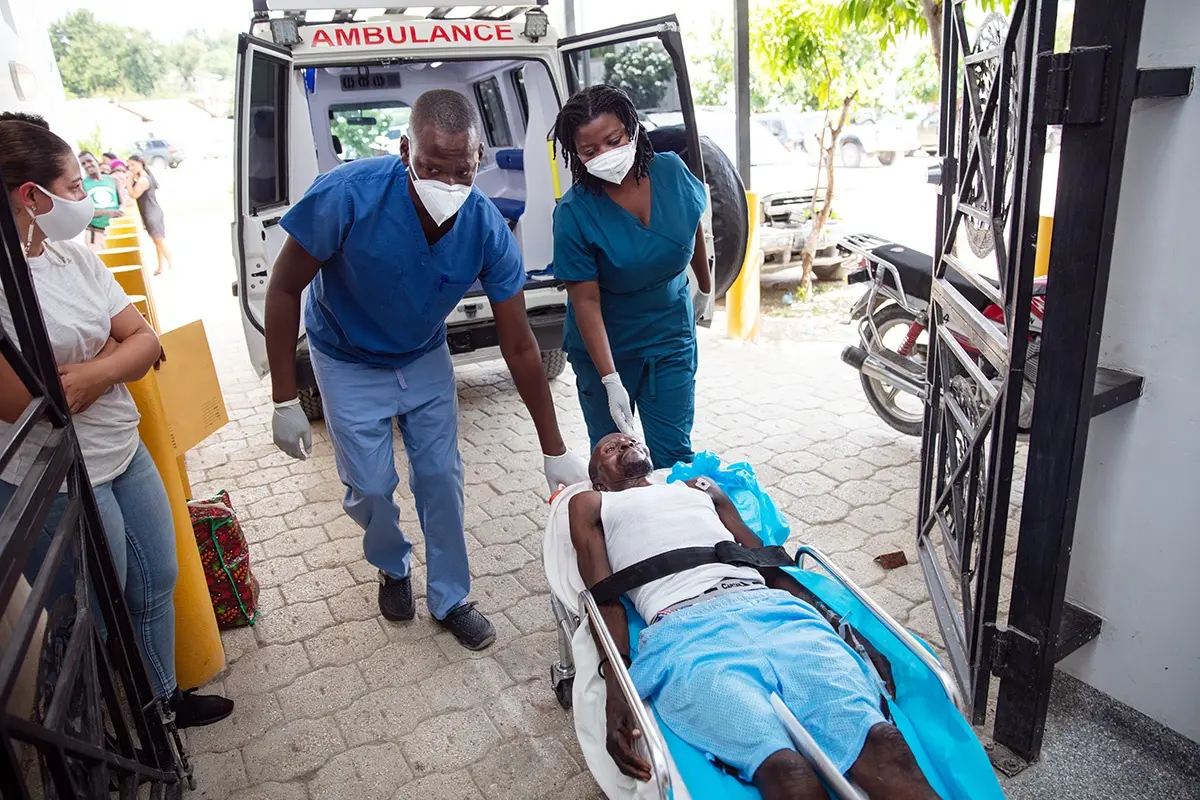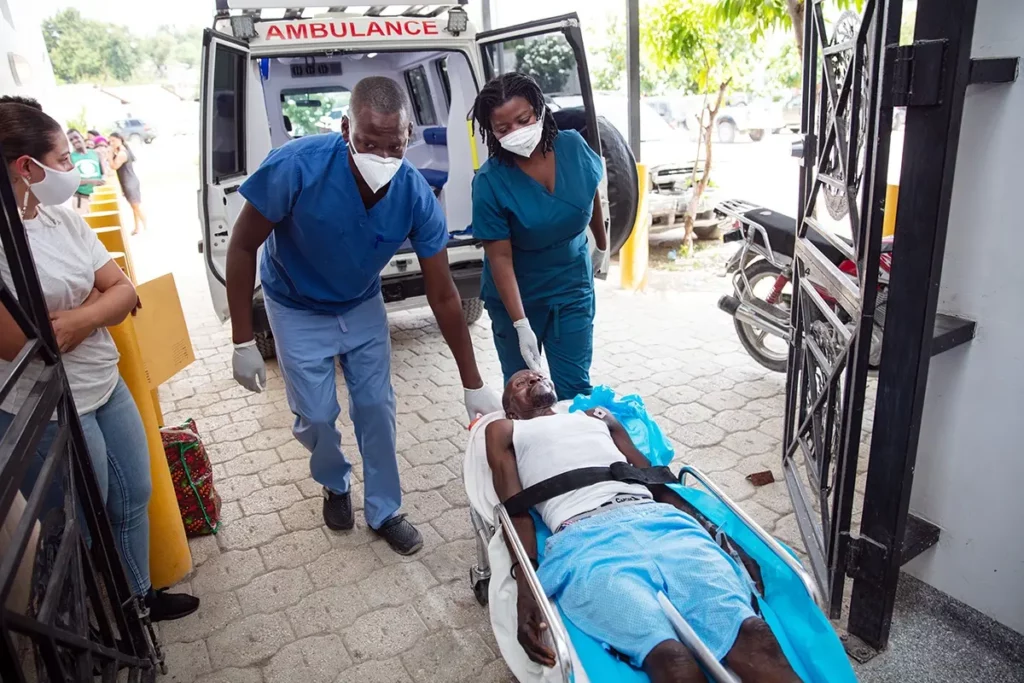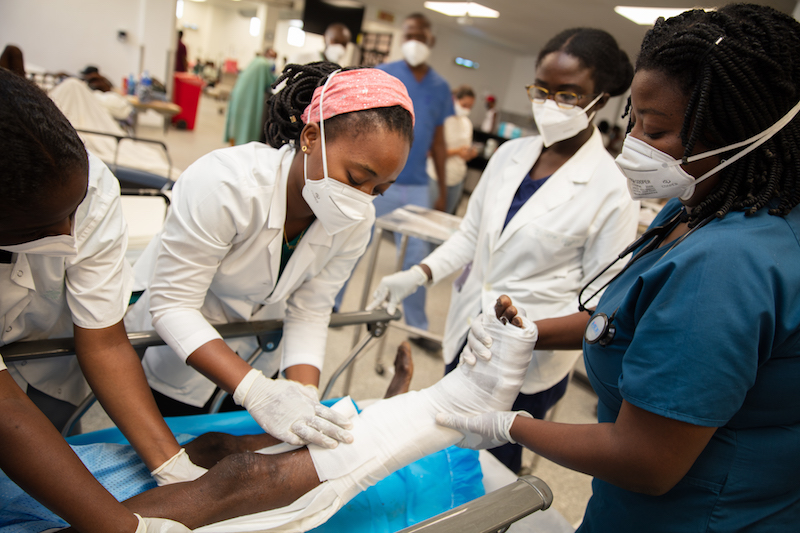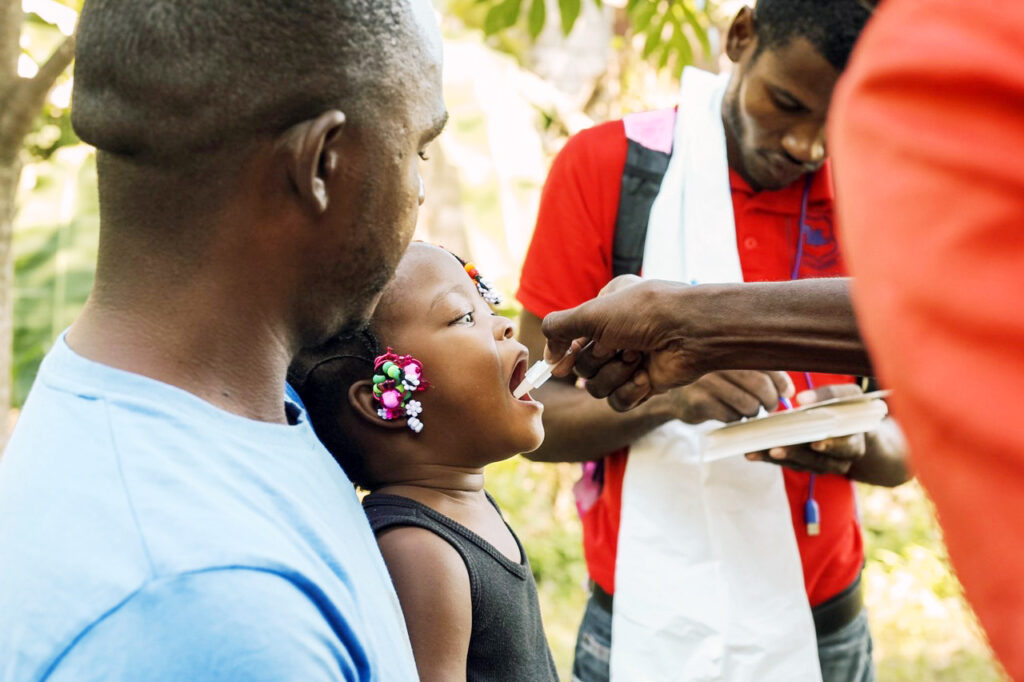Q&A: Why Emergency Care Matters

PIH director of emergency care on global training, improving patient outcomes
Posted on February 15, 2023

Dr. Shada Rouhani thinks about emergencies often: How to prevent them, manage them, and better equip doctors and hospitals to handle them.
As Partners In Health’s director of emergency care, Rouhani has, for many years, been deeply involved in developing innovative ways to deliver high-quality emergency care within resource-limited settings.
From 2013-2018, she was the co-director of the department of emergency medicine at Hôpital Universitaire de Mirebalais [HUM] in Haiti, a national teaching hospital run by Zanmi Lasante, PIH’s sister organization. There, Rouhani helped establish the first emergency medicine residency program in Haiti, at HUM, and continues to research the burden, epidemiology, and costs of emergency care globally. Since 2018, she’s helped PIH sites around the world strengthen their emergency care programs.
Rouhani recently returned to Boston from Sierra Leone, where PIH is rolling out an emergency medicine certificate for local health workers. We spoke to her about the importance of emergency medicine and how it’s evolving around the world.
Why Does Emergency Care Matter?
Emergencies happen everywhere and they happen to all of us. But where you are in the world when an emergency happens disproportionately determines your outcome. No matter if we are talking about trauma, or acute exacerbations of a non-communicable disease like asthma or heart problems–when it comes to emergencies, the outcomes for patients in middle- and low-income countries are worse.
How Much Worse?
Much worse.
The overall burden of emergency disease is estimated to be got four-to-five times higher in low-income countries compared to high-income countries. But the availability and quality of emergency care is very limited. One study found that the death rate in emergency departments in low-income countries was 45 times higher than in the U.S.
Over half of the entire, worldwide burden of disease could be treated with emergency care. That translates into over 28 million deaths annually from emergency medical disease.
There is a tremendous unmet need.
What tends to contribute to this higher mortality in countries with fewer resources?
Simply put, people don’t have access to high-quality emergency care, or any emergency care at all. Despite the higher burden of emergency disease, emergency medicine is much less developed in lower income countries.
It starts with the spaces: many hospitals don’t have emergency rooms at all, or people may have to travel great distances to reach care.
Even where there is an emergency room, it often lacks the key components needed to deliver care. There are typically fewer staff, who are usually not trained to deliver emergency care. Facilities lack supplies—and we’re not talking about fancy machines here. Facilities don’t have the basics, like IV fluids, antibiotics, and oxygen. In many ERs, when these supplies are not available and you come in for a crisis, the doctor has to hand you a prescription to go buy IV fluids, antibiotics or basic supplies like gloves so the doctor can examine you. Even if a family member has money to go and buy those supplies for you, by the time they come back it may be too late. The supplies need to be in the emergency department so they can be used immediately when needed. And they can’t be dependent on someone’s ability to pay.
Finally, emergency care systems are often less developed. Simple procedures that help you quickly assess and diagnose a patient can make the difference between starting a treatment right away or not. And though it sounds cliché, in emergencies, minutes matter. So those systems, those delays, can be the difference between life and death.
How does this two-tier system play out?
Take the example of triage. In the U.S., when you’re in the ER, when you get seen is based on how sick you are. This makes sure the sickest people get immediate treatment. That’s a system we take for granted. In most low-income countries that doesn’t happen. You come and you wait in line. People die waiting in line. You need a triage system and the relative cost of that is minimal.
Is emergency care all about trauma?
Trauma is one part of emergency care, but only a small part. In Haiti, for instance, only 20% of emergency patients are suffering from traumatic injuries. Most often it’s heart failure, hypertension, pneumonia, tuberculosis, cancer, and other issues that bring people to the ER. Often, it’s exacerbations of chronic conditions.
Think of asthma. Asthma can often be controlled with medications you take at home, but if you have a severe asthma attack, that’s an emergency and you need emergency treatment. During acute exacerbations like this, patients need emergency care to stay alive, and whether that’s available heavily influences your mortality.
How does the ER fit into the overall health system?
We generally think of emergency care for accidents, heart attacks, and acute health events. But its role is so much bigger. The ER is a plug-in to the health system. In many parts of the world, people are unable to seek routine preventative care. It costs money to get to a hospital and it means time away from work. So, they just go in when something’s wrong, and that generally means when something is acute, so they end up in the ER. The ER fixes the acute problem, but it can also help people to plug into more routine care to reduce future crises. We diagnose many chronic conditions like diabetes, heart disease, high blood pressure, and TB/HIV for the first time in the ER. Strong emergency care can educate these patients and connect them to long-term preventive care, which can transform and improve their lives.
In addition, the ER department touches every part of the hospital—the lab, radiology, in-patient, and other systems. Strengthening emergency care works to strengthen reciprocal operations and tends to elevate the rest of the hospital.
You oversaw the development of an improved ER system in Haiti after the 2010 earthquake. Talk about the before and after there.
Haiti is a great example of what is possible–so much has improved in terms of capacity there. When the devastating 2010 earthquake happened, there were no Haitian emergency physicians in the country. Hundreds of thousands of people died, and who knows how many of those people might have been saved if immediate high-quality emergency care was available.
The ER residency began at HUM in 2014 and has been graduating Haitian emergency physicians since 2017. It is fully self-sustaining and entirely Haitian-run since 2018. The HUM graduates now work throughout the country, strengthening care in many emergency departments.
As many people know, Haiti unfortunately was struck by another earthquake [in 2021]. But the difference in access to emergency care in 2021 compared to 2010 was like night and day. Haitian emergency physicians—all of whom graduated from HUM since 2017— were involved in the response in so many ways, from working at a major referral hospital near the earthquake to receiving patients at other hospitals around the country to accompanying them in the air ambulance in between.
And they provided high-quality, top-notch emergency care in every one of those roles.

For people in the U.S. and other wealthy countries, what do we need to understand about ER care in lower- and middle-income countries?
First, you need to understand that the space and the staffing are very different, which translates into different care. When people in the U.S. think about emergency rooms, they think of arriving first in an area where cases are triaged to determine who needs to be treated first, then eventually going to a private treatment room to be seen by a provider. In the US, the vast majority of emergency patients are seen by emergency physicians, with specialized training in the diagnosis and management of emergent conditions.
Compare that to many low-income countries. In many hospitals, the emergency room is just that: a room, usually a small room with three or four beds crammed in; there may be a nurse assigned there, but the doctor or provider is probably responsible for other parts of the hospital and occasionally stops in the ER. They probably don’t have any specific emergency training. This leads to people being misdiagnosed, because people come in with symptoms rather than a label saying what their problem is. For instance, if someone comes to the hospital because they can’t breathe it could be pneumonia, heart failure or even a car accident leading to a collapsed lung. You need someone trained to discern between these because the treatment for each one is incredibly different. You also need someone trained to start treatments right away before all the test results come back— in the ER you need to be diagnosing while you are intervening.
Is there anything currently underway to improve ER care at PIH sites?
Lots. The emergency medicine residency continues to train new providers at HUM in Haiti, and we have a new emergency ultrasound fellowship there that is training Haitian emergency physicians in advanced diagnostic skills. PIH-Sierra Leone just launched a certificate in emergency care—a 12-week course focusing on the most essential emergency care. It’s training the frontline ER providers at Koidu Government Hospital as well as students who will go on to practice in different locations. The team there also just finished a national survey of emergency care capacity around the country that will help guide future national planning. And those are just some of the activities–our teams in Liberia and Mexico also have ongoing trainings as well.
All of that, is only the tip of the iceberg of what is needed. Within the next five years, we hope to find the resources to expand trainings and systems even further and make PIH facilities national training hubs for emergency care.
Originally published on pih.org



